200933 Preventing mooring accidents
Adapted from UK P&I Club's Loss Prevention Bulletin January 2009 Statistical evidence shows that in 53 per cent of all cases of personal injuries arising from mooring incidents, ropes (wire or fibre) have parted under load and personnel within 'snap-back zones' have been hit.
In 42 per cent of cases, ropes/wires have not parted, but injuries have resulted from ropes jumping/slipping off drum-ends or bitts, or personnel being caught or 'dragged' by ropes, fixtures coming off mountings and from other causes.
Risk assessment of mooring stations
A risk assessment should be made of all mooring areas on board, looking at each area with a view of purposely searching for hazards that may cause injury.
Trip hazards and other obstructions
Mooring areas naturally contain many trip and obstruction hazards, and highlighting these is a good starting point.
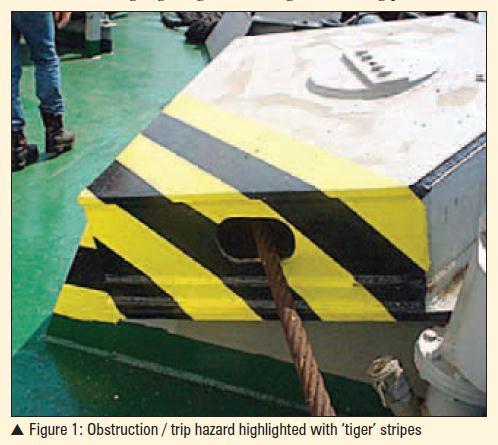
Snap-back zones
When ropes under stress break, or if tension is suddenly released (for instance when a mooring line that is jammed on a bollard under another vessel's lines, or is otherwise obstructed in any way, and suddenly clears under tension), the free end tends to 'whip' or 'oscillate' violently (see incident under 'Maintenance'). It is possible to estimate the limits of these 'snap-back' zones and if they are highlighted on the deck, the mooring crew can avoid standing inside or close to these danger areas.
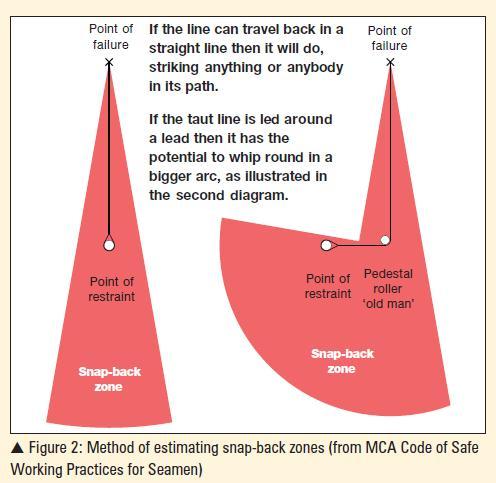
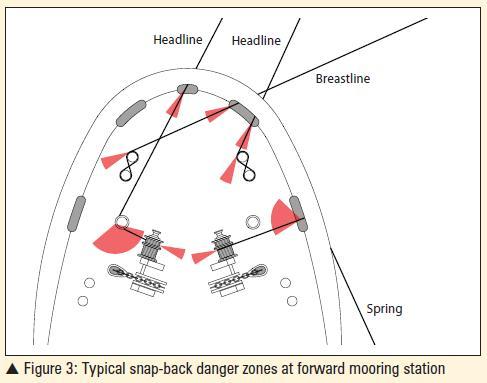
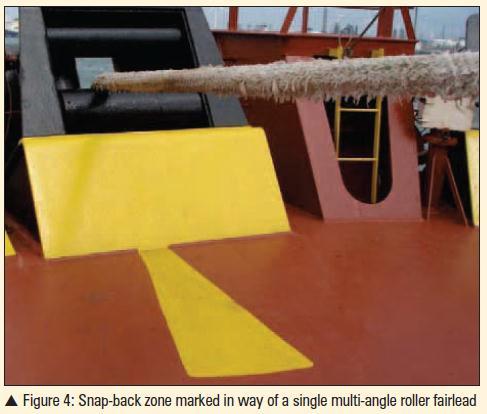
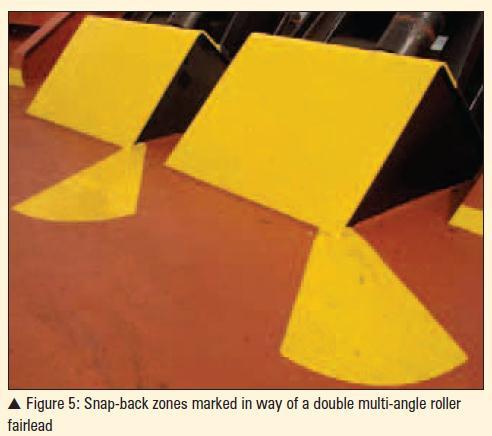
– Caution: Depending upon point of failure and chosen leads, a snap-back zone could potentially extend over a larger area than those illustrated in the above diagrams and photographs: Editor.
Maintenance
An AB was seriously hurt when a roller fairlead detached from its pedestal while bearing the load of a mooring line under tension. He was standing in the snap-back zone and was struck by the oscillating rope, which hurled him into the foremast causing head injuries. The detached fairlead roller was projected six metres from the ship on to the quayside.
The angle or directional lead of a rope should be considered when using leads in order to prevent incidents like this. But this particular incident also highlights the importance of proper maintenance of mooring equipment. The maintenance schedule shall confirm the general soundness of all components and attachments, and must ensure that every grease nipple is tightly fixed, is undamaged, clear and the spring-loaded ball, if fitted, is functioning correctly. It is a good idea to highlight grease nipples with a highly visible colour in order to prevent them from being overlooked.
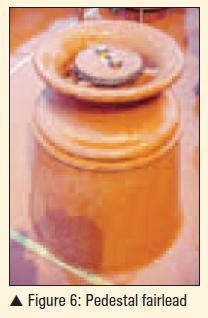
Figure 6 shows a pedestal fairlead that is well maintained. There is evidence that it has recently been turned and greased and the grease nipple on top is highlighted.
Not only should moving parts be greased, and surfaces suitably coated, but metal that is wasted should be replaced and not simply painted over. Mooring equipment that has suffered severe wastage will not perform to the certified standard. This also applies to the steel to which the equipment is welded.
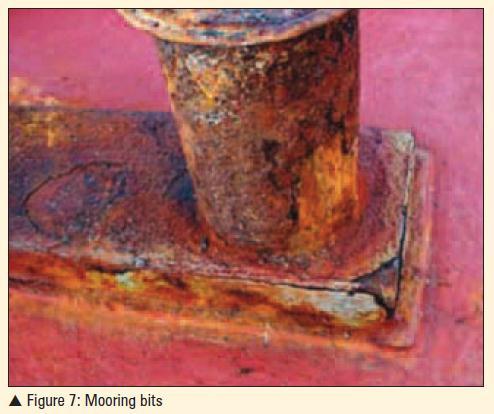
Figure 7 shows mooring bitts that are badly wasted. The deck is in equally bad condition and there is a danger of the bitts being torn from the deck.
Bights and entanglements
Numerous accidents, many of them fatal, have involved seamen being caught in bights of or getting entangled with mooring ropes in motion and being dragged into mooring equipment or fittings. The following illustration shows the reconstruction of an accident site, where a seaman was dragged through mooring bitts by a surging mooring line and was fatally injured.
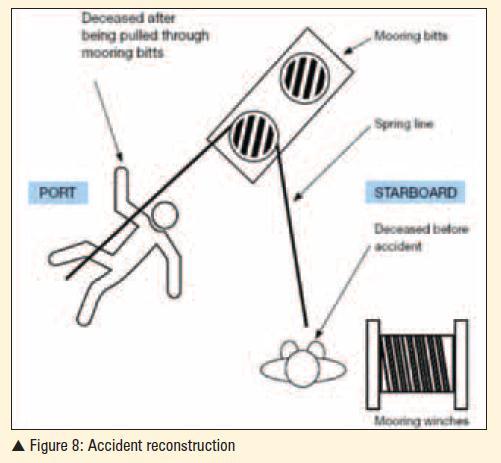
In the above incident, the mooring party forward informed the bridge that all lines were clear when they were, in fact, still in the water. Nobody noticed that as the vessel was manoeuvring away from the berth, one of the lines became snagged on one of the wharf buttresses. The unfortunate seaman was recovering the line but stepped in a bight of the mooring line as it suddenly became taut and was then dragged through the bitts as the fouled line surged out of control.
It is important to remember that bights don't always look like bights. Figure 9 shows a seaman who has inadvertently stepped over the line and put himself at risk.
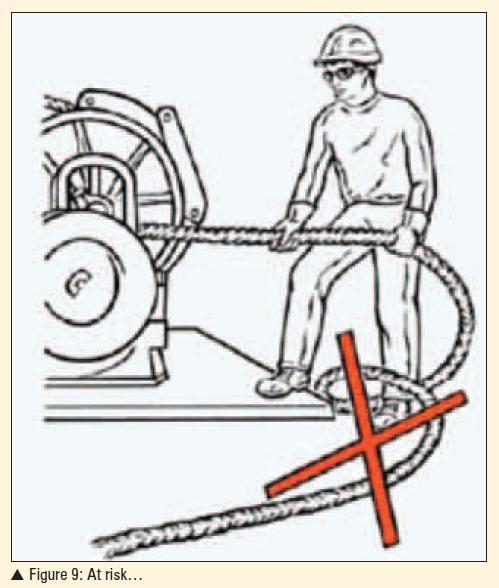
The mooring team
Mooring operations are hazardous, mainly because of the great loads the mooring lines are subjected to, which means that they are likely to part with little warning and great force. Only personnel involved in mooring operations should be present at mooring stations. It should be policy onboard that inexperienced personnel who are to be involved in mooring operations, such as cadets in the early stages of their training, should be under the supervision and direction of an experienced seafarer, and both should be aware of who is undertaking that duty.
Everybody onboard should be aware that only personnel directly involved in mooring operations may visit mooring stations during mooring operations. This is best done with safety notices and implementation into on-board policies.
Given today's minimum manning scales, some ships may find themselves stretched for manpower. Nevertheless, mooring operations should never be undertaken with fewer crew than is considered necessary to do the job safely. There should always be a minimum of two people to each mooring station throughout the operation. Even where automatic mooring systems are installed, a second person should always be present in case something goes wrong.
Crew members should not be allowed to operate a windlass or capstan and handle the rope at the same time. This is a two-person job. Fixing a lanyard to an operating lever and pulling on it from the rope-handling position should strictly be forbidden. If only two crew members are on deck for mooring operations then they should work together on the lines at one end of the vessel and then the other.
Personal protective equipment (PPE)
A vessel moored alongside during cargo operations was fully laden with her deck level below the dock level. It was noticed from the quayside that the forward spring was caught under a padeye located on the ship's side. The spring, a wire rope, was taut and there was concern that in this position it might break. An attempt was made to free the line by slacking and hauling it on the windlass but due to the curvature of the forward hull section, and the extremely long lead of the spring line, it would not free. The line was heaved taut in the hope that it might jerk free. When the line did free itself suddenly, it oscillated with such amplitude that a young engineering cadet, who was passing nearly two metres inboard of the ship's rail, was struck on the head. He was not involved in the line-clearing operation, and the mooring team attempting to clear the spring was unaware of his presence until after the accident. He was also not wearing a hard hat.
In this incident, the spring line had an extremely long lead. A bollard was available closer to the bow of the ship but this was not used. It was found that if the nearer bollard had been used then the line would probably still have become caught under the padeye, but it is unlikely that it would have jumped inboard of the ship's rail upon freeing from the padeye. This incident highlights the need for control over people present at mooring stations, the vital importance of PPE and efficient mooring arrangements.
While full overalls, safety boots and hard hat are the minimum items of PPE for mooring operations, it has been the general opinion on some vessels that wearing gloves when handling mooring ropes is an unsafe practice. This is due to concern that loose gloves may become trapped under a line on a warping drum and haul the crew member over it. Gloves should be worn but crew need to be aware of the dangers associated with ill-fitting gloves when handling ropes.
